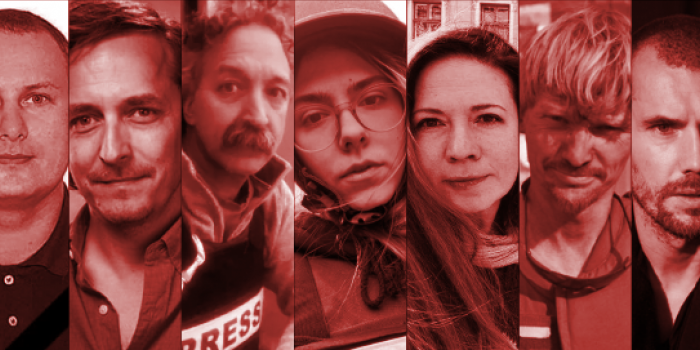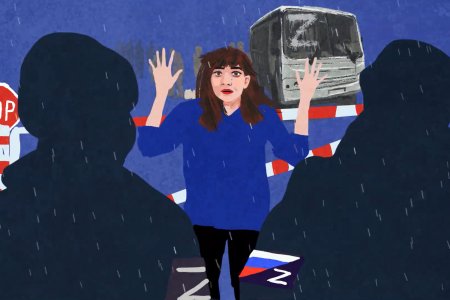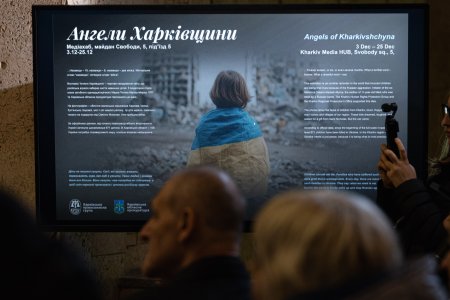
Radio Liberty journalist Vira Hyrych was killed on 28 April, when a Russian missile hit her apartment block in Kyiv. The first direct Russian attack on the capital in two weeks had almost certainly been timed to coincide with the visit by UN Secretary General Antonio Guterres, with Russia not concerned which civilians were killed. According to the Institute of Mass Information [IMI], Vira is the 22nd journalist killed since Russia launched its full invasion of Ukraine on 24 February. Of these, seven were killed while carrying out their work. They included Yevhen Sakun, a cameraman who died when Russian deliberately targeted a television tower in Kyiv on 1 March (and also bombed Babyn Yar, site of one of the worst Nazi atrocities of the Holocaust).

Shortly after this, on 5 March, the international NGO Reporters Without Borders filed a formal complaint with the International Criminal Court over Russia’s attack on that and three other Ukrainian radio and television towers since 1 March, which the NGO unequivocally calls war crimes. It said that “these strikes against telecommunications antennae show a clear intention by the Russian armed forces to prevent the dissemination of news and information.” By 24 April, there had, in fact, been 11 cases in eight regions where TV towers were shelled, with Russian airstrikes resulting in Ukrainian broadcast being totally or partially eliminated in the regions involved.
A large percentage of the 243 crimes against journalists and the media which IMI has recorded since 24 February have also served much the same purpose. The Russian invaders have, in areas under their control, resorted to abductions, threats against media owners and journalists, torture and intimidation to try to force the media to produce pro-Moscow propaganda and to replace Ukrainian media with propaganda media from Russia or occupied Crimea and Donbas.
All of this was first seen after Russia’s invasion of Crimea and military aggression in Donbas, and has led to a situation where both areas were, in 2021, rated by Freedom House as near North Korea, and categorically “Not Free”. Russia is likely to plummet even lower in freedom of speech ratings this year because of its draconian measures against any Russians or Crimeans who oppose its war against Ukraine. Since 24 February, Russia has just as clearly tried to strangle the media and free thinking on any parts of Ukraine that it succeeds in occupying.
IMI’s figure of 243 crimes against journalists and media was given on 24 April, and is certainly out-of-date, as well as likely incomplete simply because of the impossibility of fully assessing the situation until the Russians are driven out of those areas they have seized.
The seven journalists killed while working in their field were: Ukrainian cameraman Yevhen Sakun; US documentary filmmaker Brent Renaud; American cameraman Pierre Zakrzewski and a 24-year-old Ukrainian journalist Oleksandra Kuvshynova, who were both working for the US channel Fox News; Oksana Baulina, a Russian independent journalist (working for Insider); Maks Levin, the renowned Ukrainian photographer and documentalist, and the Lithuanian documentary film director Mantas Kvedaravičius.
The list includes eight cases where journalists were abducted, with at least nine journalists seized by the Russians. Most have since been released, but the whereabouts remain unknown of Dmytro Khyliuk who disappeared in Kyiv oblast. In fact, IMI says that 15 journalists are missing, with the whereabouts of 14 journalists from besieged Mariupol unknown.
Other crimes include threats and persecution of journalists; the shelling and/or seizure of TV towers; hacker attacks on media websites; the shelling of editorial office, as well as removal of access to Ukrainian broadcasting and media, either on territory recently seized by the invaders, or in occupied Crimea and Russia. At least 106 regional media have been forced to stop publishing due to threats from the Russians, seizure of their editorial offices, etc.
All of the efforts are aimed at either intimidating journalists into collaborating with the invaders, or falling silent. As reported, this was seen soon after the Russians seized Berdyansk (Zaporizhzhia oblast). They seized both the Berdiansk radio station ‘Azovska Khvylya’ [‘Azov Wave’] and the building of the local media holding ‘PRO100’, which includes the ‘South’ TV company; Azovska Khvylya; Novyny Berdianska [News of Berdiansk] and at least two other publications. Armed Russian soldiers appeared at the latter office and held around 50 employees hostage for five hours, trying – unsuccessfully - to persuade them to collaborate with the invaders and form their propaganda mouthpiece.
One of the journalists, having safely left occupied territory, told the BBC that he had been forced to lie on camera and ‘declare war against so-called ‘Ukrainian nationalists’”, with the Russians threatening to post this video if he refused to collaborate. The methods used including beatings and what were, effectively, mock executions. He believes that five or six of the armed men were from the Russian FSB [security service]. They told him, “now this is Russia, and if you want to live, you’ll have to cooperate”.
Having failed to persuade real journalists to collaborate, the Russians launched their own propaganda radio station, with Detector Media sent an audio tape of the first messages broadcast. The Russians’ claim is that they are “clarifying the picture of events”; that Ukraine is supposedly “in an information vacuum” and that “a misunderstanding” has arisen in the city administration and among the population regarding the presence of Russian occupation forces. The propaganda continues as follows: “It is in these difficult conditions that the Russian leadership decided on the demilitarization and denazification of Ukraine. It is necessary to disarm the illegal armed formations acting on Ukrainian territory and stop the activities of nationalist structures. Our joint task is to reinstate the normal work of the state authorities, industry and business and to create the conditions for the uniting of the Russian Federation and Ukraine.”
Essentially all of the methods cited by IMI seek to install either collaborators or Russian propaganda media and ensure that the local population is deprived of accurate information about what is happening. The manipulation and propaganda have been particularly brazen with respect to Mariupol where Russia is using the same methods of torture, threats and general intimidation to push extraordinary lies, blaming Ukrainian soldiers for war crimes like the bombing of the maternity hospital.
Although crimes against journalists and the media were recorded in 16 regions or oblasts, the largest number were in Kyiv and Kyiv oblast, with these including killings; injuries; disappearances; abductions; the shelling of journalists and TV towers; threats and cyber-attacks. Most of these crimes were also widespread in the Zaporizhzhia and Kherson oblasts.



